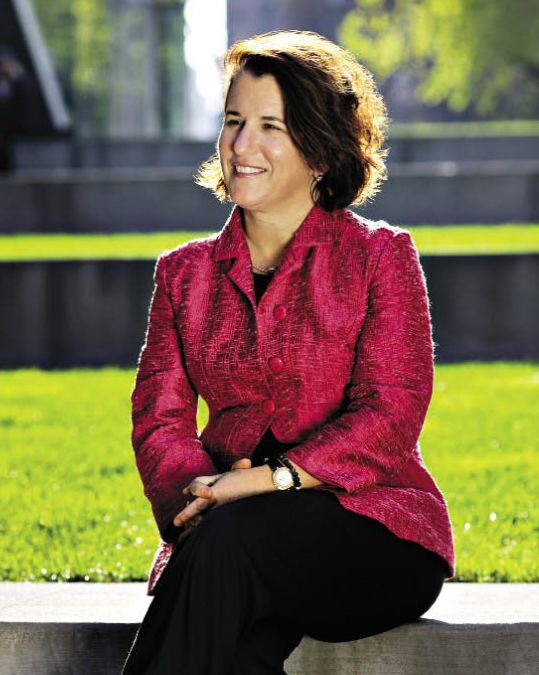As much of the nation continues to stay home to flatten the curve of infections and hospitalizations from the COVID-19 crisis, the economic impacts compound. With unemployment at an all-time high as businesses in every sector struggle to survive social distancing, the United States economy's ability to make a quick recovery becomes more and more uncertain.
For several weeks, members of Barnard’s leadership and professors from the College’s Department of Economics have been stepping up to advise the nation on the pending economic tumult that we will collectively face on the other side of this pandemic. We spoke to four thought leaders at Barnard to break down how this crisis will intersect with existing financial gender inequality, where the Federal Reserve finds $2.3 trillion, and how to restructure the economy to better weather future pandemics.
How will the economic impact vary across sectors?
 Provost, Dean of the Faculty, and Claire Tow Professor of Economics Linda Bell: The economic impact of the global spread of COVID-19 across the world is both immense and unpredictable, predicated on public health outcomes and medical treatments, the timeline for which is as of yet unknown. The facts we do know are harsh enough — a contraction of the U.S. economy of close to 5% from January through March of 2020, and grave pronouncements that the U.S. economy is in the worst shape that it has been in since the Great Depression — despite Federal Reserve actions to pump $2.3 trillion into the economy and a 0% interest rate target for the foreseeable future. What remains unknown is therefore not just how bad the situation could get — skyrocketing jobless claims and the expectations of unemployment rates not seen in the U.S. since the Great Depression — but how bad and for how long.
Provost, Dean of the Faculty, and Claire Tow Professor of Economics Linda Bell: The economic impact of the global spread of COVID-19 across the world is both immense and unpredictable, predicated on public health outcomes and medical treatments, the timeline for which is as of yet unknown. The facts we do know are harsh enough — a contraction of the U.S. economy of close to 5% from January through March of 2020, and grave pronouncements that the U.S. economy is in the worst shape that it has been in since the Great Depression — despite Federal Reserve actions to pump $2.3 trillion into the economy and a 0% interest rate target for the foreseeable future. What remains unknown is therefore not just how bad the situation could get — skyrocketing jobless claims and the expectations of unemployment rates not seen in the U.S. since the Great Depression — but how bad and for how long.
Alongside the discouraging general economic news is the harsh reality that the “hit” will not be equally shared. The economic decline will impact key sectors, occupations, individuals, or businesses disproportionately. Some industries will be particularly hard hit — those where remote work is either not possible (such as in product manufacturing) or a diversion from the service delivery model (such as restaurants, retail stores, or real estate). Individuals will be diversely impacted, with more economically vulnerable workers in less skilled occupations (home service workers, custodial workers, and cashiers, for example) unequally and disproportionately affected. Similarly, small businesses that rely on cash and access to credit will be particularly vulnerable and especially so depending on the duration of the pandemic and the length of time it takes to resume work as normal. The economic impact will be huge, the distributional consequences unequal, and the long-term severity and damage to the economy as yet unpredictable.
For the first time in modern economic history, we face an economic crisis predicated not on unstable markets or economic surprises on the supply or demand side. Predicting the long-range economic fallout of COVID-19 will therefore only be possible when we have the necessary information to accurately predict when we can safely go back to work as a society, and return with confidence, in a manner that is at least reminiscent of the workplaces we abruptly vacated this spring.
Bell is an empirical economist specializing in labor markets and public policy. She previously served as a senior economist in the research department of the Federal Reserve Bank of New York. She has also been a board member on the Committee on the Status of Women in the Economics Profession of the American Economic Association.
How might working women’s “second shift” of taking on the majority of household responsibilities worsen during the COVID-19 quarantine, and what effects will that have on the economy in the long term?
 Assistant professor of economics Belinda Archibong: In my research on the effects of epidemics on gender inequality, I’ve noted that negative shocks to society generally disproportionately harm women. When households are facing significant negative economic events, like lost income, lost work, or increased health costs from an epidemic or pandemic like COVID-19, women tend to bear a relatively larger share of the impacts. Two ways in which this can happen, as I’ve studied in my work on epidemics, is through increasing gender gaps in what economists call human capital investment, like investment in education and in the labor market.
Assistant professor of economics Belinda Archibong: In my research on the effects of epidemics on gender inequality, I’ve noted that negative shocks to society generally disproportionately harm women. When households are facing significant negative economic events, like lost income, lost work, or increased health costs from an epidemic or pandemic like COVID-19, women tend to bear a relatively larger share of the impacts. Two ways in which this can happen, as I’ve studied in my work on epidemics, is through increasing gender gaps in what economists call human capital investment, like investment in education and in the labor market.
If women are expected to take on the majority of home production or housework, then when schools close or family members are sick, girls and women in the household may be left with increased responsibilities related to care work or assisting with younger siblings’ or household members’ schoolwork. This means less time devoted to the woman’s own schoolwork, which could widen achievement and education gaps for women as a result.
Similarly, if working women earn less than men in the labor market on average, have lower labor force participation rates, and tend to be more represented in some of the hardest-hit sectors from the pandemic, like service sectors, then higher unemployment rates and lost wages disproportionately harm women.
This means that in the long term, unless large-scale targeted financial resources are provided to households, with a particular focus on the differential effects of COVID-19 by gender, we may see a worsening of gender inequality and a widening of gender gaps in education and employment. [Both] will have significant negative consequences for the economy at large, unless, as we’ve documented in previous research, there is decisive government action to direct resources to mitigate these impacts.
Archibong’s research focuses on the role of historical institutions and environment in inequality of access to public services and the development of human capital, especially in African nations. In addition to teaching at Barnard, she is a faculty affiliate at Columbia University's Center for Development Economics and Policy (CDEP), The Earth Institute at Columbia University, the Institute of African Studies, the Institute for Research in African-American Studies, the Columbia Population Research Center (CPRC), and the Center for Environmental Economics and Policy (CEEP). Read her recent commentary in the San Francisco Chronicle, Thrive Global, Fortune, and The Christian Science Monitor.
How does the Federal Reserve find an extra $2.3 trillion, and where will that money go once the crisis is over?
 Assistant professor of economics Martina Jasova: One of the key roles of central banks is money creation. That means that the Federal Reserve does not need to find money to run an expansionary policy and help the economy — it creates the money. As a result, the Federal Reserve is able to fund itself, and its expenses are generally not part of the U.S. federal budget.
Assistant professor of economics Martina Jasova: One of the key roles of central banks is money creation. That means that the Federal Reserve does not need to find money to run an expansionary policy and help the economy — it creates the money. As a result, the Federal Reserve is able to fund itself, and its expenses are generally not part of the U.S. federal budget.
The simplest way to imagine money creation is that the Fed buys Treasury bonds and other debt and creates bank reserves, or money. As these securities pay interest and/or their prices increase, the Fed can make a profit. If the central bank makes profit, it tends to pass it over to the Treasury. Historically, we have seen the Fed make profits in almost all operations, including those introduced during the [2008] global financial crisis. Some have gone as far as to call the Fed “the most profitable bank in the world.” It is, however, important to point out that under normal circumstances, the Fed’s operations are very conservative and the central bank invests in less risky assets, such as government treasuries or securities [that are] issued or guaranteed by the government or government-sponsored agencies.
Given the growing fears of a severe impact by COVID-19 on the U.S. economy, the Fed has been trying to use its powers “forcefully, proactively, and aggressively.” Most recently, this can be seen in a bundle of nine lending programs that are estimated at the unprecedented $2.3 trillion, [which is] 11-12% of the GDP. Unlike previous operations, the lending programs are much riskier, as they aim to directly help states, cities, and businesses whose revenues are disappearing amid the COVID-19 [crisis].
As a result, it is not completely unimaginable that the most profitable bank in the world might actually lose the money this time. To prepare for that possible scenario, Congress and the Treasury have been extending substantial [amounts of money] that could help cover for potential losses that the Fed might sustain in these lending programs.
Jasova focuses on the linkages between macroeconomics and finance in her research. In addition to teaching, she is a research associate at the Center for Japanese Economy and Business at Columbia University.
How can we restructure our economy to better weather the impacts of a pandemic?
 Professor of economics Rajiv Sethi: More than 26 million people have filed initial claims for unemployment insurance over the last five weeks, reflecting an economic collapse that is unprecedented in speed and scale. There are some who believe that a recovery from this will be equally strong and swift, after a few weeks of social distancing. The Secretary of Labor, for example, has stated that he expects us to “spring back to the strong economic conditions we enjoyed just weeks ago.”
Professor of economics Rajiv Sethi: More than 26 million people have filed initial claims for unemployment insurance over the last five weeks, reflecting an economic collapse that is unprecedented in speed and scale. There are some who believe that a recovery from this will be equally strong and swift, after a few weeks of social distancing. The Secretary of Labor, for example, has stated that he expects us to “spring back to the strong economic conditions we enjoyed just weeks ago.”
This view is untenable. Under current policies, we are likely to see ebbs and flows in infections over a year or more, in concert with the relaxation and tightening of social distancing measures. The economic and social consequences of this would be unimaginably dire. We desperately need an alternative approach.
Over the past few weeks, I have been working with a team, led by Danielle Allen of Harvard University, on a strategy that we call mobilize and transition to pandemic resilience. This involves testing on a massive scale, upwards of several million individuals per day. Those with a recent negative disease test or a serological test indicating immunity can return to the workforce, while those who test positive can be isolated and assisted, with finely targeted contact tracing used to identify others at risk. Taiwan and Singapore have been effective in implementing strategies of this kind.
There will still be severe economic hardships for millions along the way, for which we need a robust social support system. But the mobilize-and-transition strategy allows for a return to participation in economic and social life for most of us long before the pandemic has been fully contained and will result in lower mortality and faster economic recovery than strategies that rely primarily on waves of massive and indiscriminate social distancing.
Sethi’s research areas include microeconomics and game theory, with applications to inequality, crime, communication, and finance. He is an original contributor to CORE (Curriculum Open-Access Resources for Economics), an organization dedicated to the production of high-quality resources for the teaching of economics, distributed free of charge worldwide under a Creative Commons license. His book Shadows of Doubt: Stereotypes, Crime, and the Pursuit of Justice, written jointly with Brendan O’Flaherty, was published in 2019. He is also an external professor at the Santa Fe Institute and is on the editorial boards of the American Economic Review and Economics and Philosophy. Read his recent commentary in Bloomberg, Vox, Santa Fe Institute, and the Santa Fe New Mexican.
More from Barnard’s experts: Five Tips for Getting Through COVID-19
—VERONICA SUCHODOLSKI ’19
Barnard experts explain.
